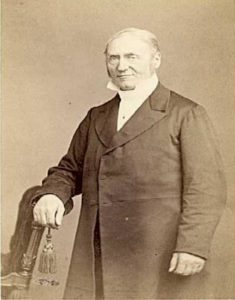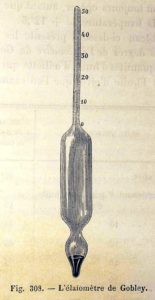
11 May 1811 – 1 September 1876

He was born in Paris (France) and died in Bagnères-de-Luchon (France).
As a young boy he worked with the successor of Vauquelin, the famous chemist and pharmacist Pierre Robiquet (1780-1840) who identified several amino acids and discovered codeine. He received his diploma in pharmacy in 1835 and practiced his profession for many years.. After he was internship in an hospital, he purchased its own pharmacy in 1837 in Paris and kept it until 1861. Besides its tasks, he found time to make several researches in chemistry. He was “professeur agrégé” at the school of Pharmacy from 1842 to 1847. In 1861 he was elected to the Academy of Medicine.
Gobley dealt with a wide variety of subjects but he remains famous for his studies on the composition of hen’s egg yolk, brain of several species, and carp organs. His most significant work concerned the chemistry of what we now name phospholipids.
In 1845 he discovered in egg yolk a phosphorylated lipid which he named in 1850 “lecithin” (in greek lekithos = egg yolk). While he was unable to describe its structure, he noted that its hydrolysis yielded fatty acids and glycerophosphoric acid (Gobley N, Sur l’existence des acides oléique, margarique et phosphoglycérique dans le jaune d’oeuf. Premier Mémoire: Sur la composition chimique du jaune d’oeuf, C R hebd Acad Sci 1845, 21, 766). He detected that there was also a base he thought to be ammonia.
In 1846, three famous chemists, Chevreul, Dumas and Pelouze, made a report for the Académie des Sciences on the previous Gobley’s memoir and insisted on his discovery of glycerophosphoric acid in egg yolk:
“La partie la plus intéressante peut-être du jaune d’oeuf, celle qui contient le phosphore qu’on sait y exister en grande quantité, a été l’objet des recherches persévérantes de M. Gobley, et ces recherches ont été couronnées d’un succès réel, car il a fait connaitre l’état de combinaison jusqu’alors tout à fait ignoré sous lequel le phosphore existe dans l’oeuf …..L’un de nous avait déjà trouvé l’acide phosphoglycérique, … mais personne n’avait pensé que cet acide, jusque là produit exclusivement par l’art, pût exister dans la nature, et M. Gobley, qui l’a découvert dans le jaune d’oeuf, s’est assuré, par des expériences nombreuses, des analyses exactes, de la parfaite identité de l’acide phosphoglycérique extrait de l’oeuf avec celui qu’on obtient directement en unissant la glycérine à l’acide phosphorique. Au point de vue physiologique, comme sous le rapport chimique, ce résultat est d’un grand intérêt.“
“Perhaps the most interesting part of the yolk, that which contains the phosphorus which is known to exist in it in great quantity, has been the object of the persevering researches of Mr. Gobley, and these researches have been crowned with a real success, for he made known the hitherto quite unknown state of combination under which phosphorus exists in the egg…..One of us had already found phosphoglyceric acid, . .. but no one had thought that this acid, hitherto produced exclusively by art, could exist in nature, and Mr. Gobley, who discovered it in the yolk of an egg, assured himself, by numerous experiments, exact analyses, of the perfect identity of the phosphoglyceric acid extracted from the egg with that which is obtained directly by uniting glycerine with phosphoric acid. From the physiological and chemical points of view, this result is of great interest“.
At the same time, Gobley confirmed the presence of cholesterol in egg yolk and quantified its amount. Thus, he determined the content of egg yolk in oil (21.3 g %) and in cholesterol (0.44 g %) (Gobley N, Recherches chimiques sur le jaune d’oeuf; Deuxième Mémoire. C R hebd Acad Sci 1845, 21, 988). Cholesterol has been first reported in gall stones by Chevreul in 1815 and later in the human blood by Louis-René Le Canu (1800-1871) (Le Canu L R, Nouvelles Recherches sur le Sang. J Pharm 1831, 17, 485-502, 545-569) and more accurately in 1833 (Thesis) by the pharmacist Henri-Félix Boudet (1806-1878).
In 1847 Gobley reported his work on brain tissue comparing its lipid content to that of egg yolk (Gobley N, Recherches chimiques sur le jaune d’oeuf – Examen comparatif du jaune d’oeuf et de la matière cérébrale. J Pharm Chim 1847, 11, 409). He described the presence in the chick brain of a lipidic substance containing phosphorus similar to that present in egg yolk. The presence of phosphorus in brain lipid extracts has been previously reported for the first time in 1811 by Nicolas-Louis Vauquelin in his medicine thesis.
In a paper published in 1847, again on the chemistry of egg yolk (Gobley N, Recherches Chimiques sur le Jaune d’Oeuf, Deuxième Mémoire, J Pharm Chim 1847, 12, 5), he affirmed again that brain tissue and egg yolk contain a phophor-rich substance containing fatty acids. Gobley can thus effectively be considered as the discoverer of phospholipids:
“J’ai répété toutes ces expériences avec la matière visqueuse phosphorée de la cervelle du poulet, du mouton et de l’homme, et je sui arrivé aux mêmes résultats. Il existe donc dans le cerveau, comme dand le jaune d’oeuf, une substance phosphorée qui, dans les conditions où je l’ai placée, m’a toujours donné, pour produits de décomposition, de l’acide oléique, de l’acide margarique et de l’acide phosphoglycérique“.
“I repeated all these experiments with the viscous phosphorus matter of chicken, sheep, and human brains, and arrived at the same results. There exists therefore in the brain, as in the yolk of an egg, a phosphorus substance which, under the conditions in which I have placed it, has always given me, as products of decomposition, oleic acid, margaric acid and phosphoglyceric acid”.
At the same time, in 1866, the German pharmacologist Oscar Liebreich (1839-1908) gave the name “protagon” to a substance he discovered in the brain and blood cells and which contained phosphorus and a specific organic base he named “neurine”. One year later, the Russian chemist W Dybkowsky demonstrated that neurine was similar to choline (Dybkowsky W, Üeber die identität des cholins und des neurins J Prakt Chem 1867, 100, 153–164).
The German chemist Adolph Strecker (1822–1871), well known for his work on amino acids, discovered in 1862 that the lecithin fraction extracted from pigs and oxen bile generated after boiling a new nitrogenous chemical he named “choline” (from the Greek “chole” for bile) and determined its chemical formula C5H13NO (Strecker A, Über eingige neue Bestandtheile der Schweinegalle. Ann Chem Pharmacie 1862, 123, 353-360). Strecker, moreover, correctly deduced the structure of lecithin (A Strecker, “Ueber das Lecithin,” Ann Chem Pharm 1868, 148, 77-90).
After that discovery by Strecker, Gobley published a paper on the chemical properties of lecithin and “cerebrine” and could established that “choline is with oleic acid, margaric acid and phosphoglyceric acid produced by the splitting of lecithin” (Gobley N, “Sur la Lécithine et la Cérébrine,” J Pharm Chim 1874, ser. 4, 19, 346-354). He announced also their presence in tissues of some lower invertebrates, such as the sea nettle, the starfish, the sea urchin, medusa, and the sea anemone.
Soon after, Gobley published several papers to summarize the results of his work on the chemistry of the brain. The best known is: Gobley N, Recherches chimiques sur le cerveau, J Pharm Chim 1874, 20, 98-99 & 161-166.
Thus, Gobley may be considered also as the discoverer of what we call today phosphatidylcholine. The discovery of this first complex lipid in the second half of the nineteenth century is intimately tied to the beginning of the modern study of the chemistry of the brain.
Gobley collaborated with the French physicist and physiologist JLM Poiseuille (1797-1869) in a study of urea in blood as well as in urine.
His research on oil led him to invented the first physical instrument devoted to these substances and called “élaïomètre”, this instrument described in 1843 was used mainly to test the purity of commercial olive oil (Nouvel Instrument D’essai Pour Les Huiles D’olive, L’huile D’amandes Douces Et Les Huiles Médicamenteuses).
“Gobley N, Note sur l’Elaïomètre, nouvel instrument d’essai pour les huiles d’olive, J Pharm Chim 1843, 4, 285“.

Gobley was not only a scientist but he also carried out public responsibilities performing charitable work and making social contributions as a member of several commissions and societies. He later became administrator, and then vice-president of the welfare offices of his district and a member of many scientific societies.
Devenez membre et participez au développement de la Lipidomique au XXIème siècle.
S'inscrire